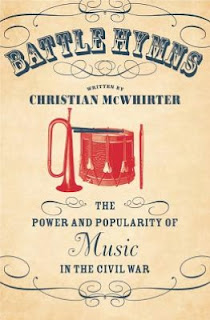 He applied the "Page 99 Test" to his new book, Battle Hymns: The Power and Popularity of Music in the Civil War, and reported the following:
He applied the "Page 99 Test" to his new book, Battle Hymns: The Power and Popularity of Music in the Civil War, and reported the following:From Page 98:Learn more about Battle Hymns at the University of North Carolina Press website, and visit the Battle Hymns Facebook page.
No wartime event inspired a greater number of political songs than the northern presidential election of 1864. This fierce affair pit Lincoln, emancipation, and the Republicans against George McClellan and the peace Democrats - sometimes called Copperheads. Campaign music had become less effective in the 1850s, but it returned to center stage in 1864 because of the intense opinions and emotions generated by the war. Although many of these songs seem trite or laughable, they helped cement the public persona of each candidate and explored the issues of the war in an accessible way.I suppose my book fails the Page 99 Test because the eponymous page mostly features an illustration but I'll bend the rules and discuss this paragraph from page 98 instead.
The introduction to my discussion of music’s role in the election of 1864 encapsulates many of the book's central themes. Both Democrats and Republicans understood that music was an extremely effective way to share their party's ideas and influence listeners. Democrats tended to focus on race and emancipation in their songs because these issues provided the starkest contrast with Republicans. On the other hand, Abraham Lincoln's supporters crafted fewer original songs. Instead, they leaned heavily on already popular tunes that supported Republican positions, especially "The Battle Cry of Freedom" and "John Brown's Body."
By using music to express their views of the war and shape the opinions of their listeners, Republicans and Democrats participated in a phenomenon that took place in every facet of American society. During the Civil War, music was one of the best ways to spread ideas quickly and effectively - and both northerners and southerners did not hesitate to do so. As a result, the war inspired a veritable flood of professional and amateur music that was used by a variety of Americans in a variety of ways.
Those songs that captured the public's attention early in the war achieved incredible popularity and remained favourites for years, especially those with political overtones such as “Dixie” and “John Brown’s Body.” However, without radio to provide definitive renditions of these pieces, revision and interpretation never ceased. Americans did not just appropriate songs to their specific causes but frequently revised and recast them to better suit their sentiments. One of the war's most enduring pieces, "The Battle Hymn of the Republic," was a result of this process; as Julia Ward Howe refashioned "John Brown's Body" to better fit her ideal vision of the northern cause. Democrats and Republicans made heavy use of music in 1864 precisely because it had been used so well and so often during the previous three years of war.
--Marshal Zeringue



